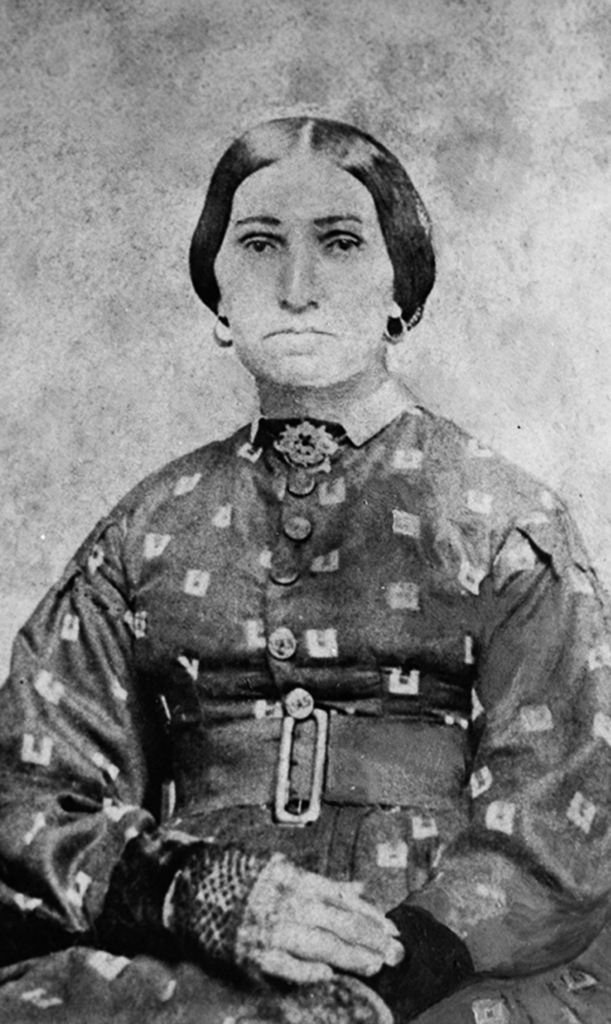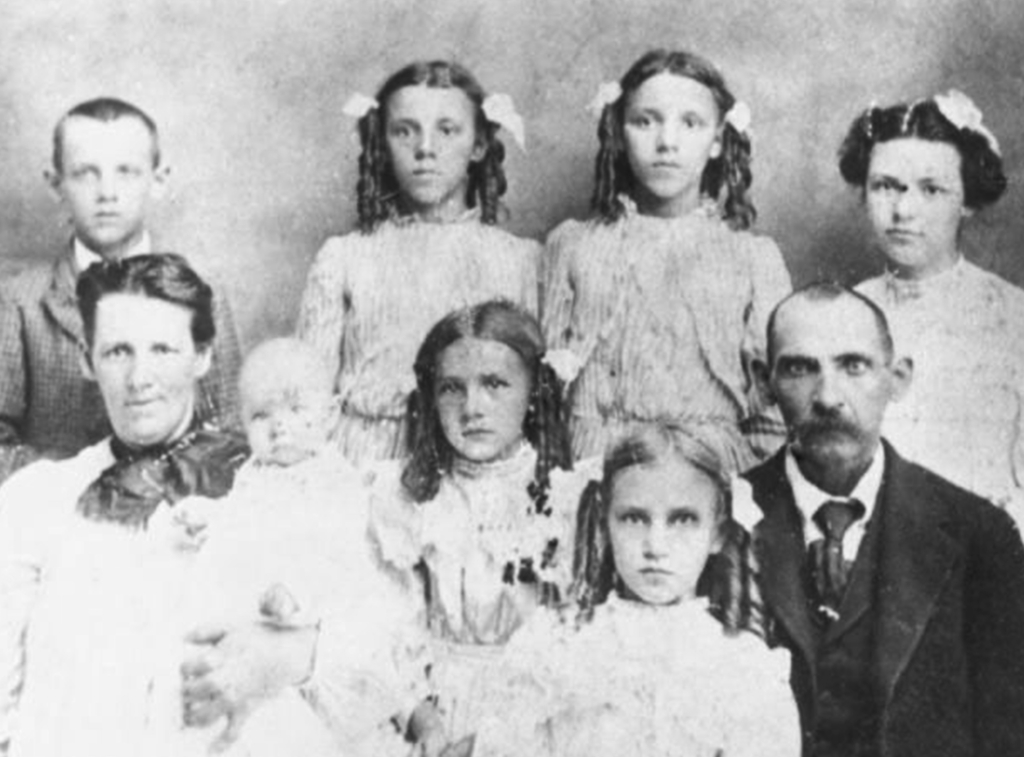The Citizen Potawatomi Nation’s Cultural Heritage Center provides resources to keep the Tribe’s history safe and accessible for generations to come. One key way the Nation does this is through the CHC’s archives and video interviews.
To highlight some of the archive’s holdings, the Hownikan is featuring photographs and family history of every founding Citizen Potawatomi family. If interested in assisting preservation efforts by providing copies of Citizen Potawatomi family photographs, documents and more, and to schedule family interviews, please contact the CHC at 405-878-5830.
Higbee-Potawatomi beginnings
The Higbee family’s Potawatomi roots stretch back to Daniel Bourassa and his Potawatomi wife. The Bourassas lived in the St. Joseph River Valley, whose villages were led by Chief Topinabee (He Who Sits Quietly). Their daughter, Madeline, married Joseph Bertrand, a successful fur trader and business owner who lived near Lake Michigan.
Madeline and Joseph’s daughter, Julia Justine, was born on May 25, 1823. She attended a small private school in the home of postmaster Squire Daniel C. Higbee. It was through Daniel Higbee that Julia met Daniel’s brother, Alva.

Many Potawatomi were forced to relocate west after the 1833 Treaty of Chicago. The treaty caused the Potawatomi to lose millions of acres of land. Julia, however, stayed in Michigan and married Alva on Oct. 4, 1848, before moving to the Potawatomi reservation in present-day Kansas in 1850. Julia’s father, Joseph Bertrand, lived with the couple until about 1850.
Julia and Alva
Julia and Alva had nine children: Josephine L., Mary Anastasia, Joseph Bertrand, Lewis B., Robert A., Lucy and George as well as Theresa and Julia who passed away as infants. Alva worked as a carpenter, and the children attended school at the St. Marys Mission.
The family expected to live a peaceful life in Kansas, but settlers and the federal government upended those plans. The reservation’s prime location along the California and Oregon trails and ongoing demand for land led to the Treaty of 1861. As a result of this treaty, the Potawatomi separated into two distinct groups. Some Potawatomi chose to receive a land allotment and potentially become U.S. citizens while others chose to remain in Kansas on an 11-square-mile reservation. The Higbees decided to receive allotments and become members of the Citizen Band Potawatomi.
Sadly, Julia passed away in 1866 due to pneumonia. One year later, the Citizen Potawatomi signed the Treaty of 1867, which provided the opportunity for Tribal members to sell land and in return, purchase a new reservation in present-day Oklahoma.
Following his second and third marriages, Alva returned to Kansas around 1882. When St. Marys incorporated as an official town in 1869, Alva became the town’s first official mayor. Later he served as the police chief, and on Dec. 18, 1884, he sadly perished while attempting to put out a fire in a building.
Higbee children
Alva and Julia’s daughter, Josephine, married Thomas Mainey (also spelled Maney). Mainey had moved to the United States from Ireland in 1861. He and Josephine wed on Feb. 23, 1868, in Kansas. They settled on a farm two miles west of St. Marys for many years before moving the farm to south of the river in Wabaunsee County. After many years of farming, Josephine and Thomas moved to St. Marys to retire.
Josephine’s obituary paid tribute to her kind nature as she was “educated in St. Marys by the Madames of the Sacred Heart, now long departed. She was a woman who had well learned what Christian charity meant in its largest meaning. Her kindly ministrations to the sick in soul and body will long be remembered, and many that are now gathered to their fathers no doubt had reason in their last hours to thank this kindly woman for moments of life made easier by her love in doing the master’s work.”
Julia and Alva’s daughter Mary Anastasia married Joseph LaReau in St. Marys on July 25, 1871, and all seven of their children were born around the St. Mary’s Mission in Kansas. In 1896, the family moved to present-day Oklahoma near Wanette. Mary Anastasia walked on Jan. 10, 1919, in Wanette.
Joseph and Mary Anastasia’s offspring quickly became prominent members of their new community. Joseph Alva (Alvie) LaReau, the oldest son, started a livery stable and feed store, and Francis Casimir LaReau (Cass) was a merchant in Wanette for many years.
Lewis Higbee lived briefly in New York before heading to Bertrand, Michigan, where he met and married Carrie Swain. The couple moved to St. Marys where they had several children. In July 1893, they settled on his 240-acre Potawatomi allotment in Indian Territory near the current border of Pottawatomie and Cleveland counties. Lewis established the community originally named Higbee. A few years later, he sold a portion of his allotment to James P. Corbett, and the town changed its name to Corbett, Oklahoma. Lewis also served as deputy sheriff for a few years.
According to Lewis’ obituary, “Mr. Higbee was one of the sturdy pioneers of this part of the state and of Cleveland county.”
Joseph Bertrand Higbee married Jenny K. Fuller and eventually settled in Lexington, Oklahoma. According to family records, they adopted a daughter. Joseph was devoted to serving the country. An April 21, 1928, article in the El Reno Daily Democrat stated that Joseph became the oldest volunteer from Oklahoma in the U.S. Army during World War I. He served two years at Camp Meigs with the 16th Company, Quartermaster Corps.
Robert Higbee and Ida Swearingen married in Kansas before moving to Indian Territory near Okmulgee in the late 1890s, and they had eight children.

Lucy Higbee wed John Louraine, and the two settled on her allotment near Lexington, Oklahoma. In 1908, she remarried Gates Angel, and she worked as a nurse in the Lexington area for many years.
A Lexington Leader article published on May 26, 1905, said the Higbees even helped bring early telephone lines to the rural areas of their community. “The Canadian river rose while they were stringing up the lines, and one of the Higbees took off his clothes and swam the river to the Rosedale side with a telephone wire, to get it across,” the article read.
A Higbee family story revealed Arthur Higbee was the individual who swam across the river, and his efforts caught the attention of Christene Elizabeth Friend. They married two years later, and she later served as the telephone operator.
George Albert Higbee married Lydia Eliza Shoemaker Smith in October 1891, and they spent most of their lives in Indiana. George moved away from St. Marys, Kansas, after attending boarding school. Together the couple had 11 children: Raymond, Luella, Hazel, Francis, Lillian, Marie, Ada, Genevieve, Celia, Alvin and Glenn.
Throughout the last two centuries, the Higbee family has continued to grow and expand, building lives throughout Oklahoma and beyond. During the Great Depression, many Citizen Potawatomi sold their allotments and belongings to seek a new life out West, including numerous Higbee descendants. Today, the family continues the Higbee legacy, serving as teachers, medical professionals, CPN employees, Tribal leaders and more.
The Citizen Potawatomi Nation Cultural Heritage Center provides resources to keep the Tribe’s history safe and accessible for generations to come. One key way the Nation does this is through the CHC’s archives and family interviews. If interested in assisting preservation efforts by providing copies of Citizen Potawatomi family photographs, documents and more, please contact the CHC at 405-878-5830. Schedule interviews online at portal.potawatomi.org. Learn more about the Family Reunion Festival at cpn.news/festival, and find research resources online at potawatomiheritage.com.
